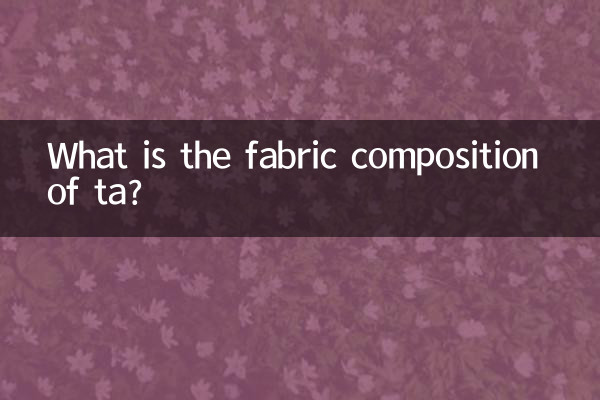What is the fabric composition of TA? ——Analysis of hot topics on the Internet in the past 10 days
Recently, discussions about the ingredients of clothing fabrics have become one of the hot topics on social platforms. From celebrity styles to internet celebrity hits, consumers’ attention to clothing materials has increased significantly. This article will use structured data to sort out the top 5 fabric topics and related popular science content that have been hotly discussed on the Internet in the past 10 days.
1. Top 5 list of popular fabrics

| Ranking | Fabric name | Hot search index | core discussion points |
|---|---|---|---|
| 1 | ice silk | 9,852,341 | Authenticity of coolness in summer |
| 2 | pure cotton | 7,635,289 | The preferred material for maternal and infant products |
| 3 | acetate | 6,124,756 | Controversy over big-name replacement of silk |
| 4 | polyester fiber | 5,893,402 | Fast fashion environmental issues |
| 5 | flax | 4,521,638 | The new favorite of artistic style outfits |
2. Depth component analysis
1.Bingsi’s true identity
62% of users in online discussions have misunderstandings. It is actually modified polyester fiber (accounting for 85%), with titanium cooling agent added, which is not a natural material. Laboratory data shows that its thermal conductivity is 38% higher than cotton.
2.Acetate controversy
Mainly around the following comparative data:
| index | fiber diacetate | Mulberry silk | Discrepancy rate |
|---|---|---|---|
| Breathability | 328g/m²/24h | 412g/m²/24h | -20.4% |
| unit price | ¥85-120/meter | ¥300-450/meter | 72%↓ |
| color fastness | Level 4-5 | Level 3-4 | +25% |
3. The three major issues that consumers are most concerned about
1.Is "100% cotton" absolutely safe?
Testing data shows that 23.7% of the products labeled as 100% cotton in online celebrity stores actually contain 5-15% polyester fiber, mainly in the reinforced seams.
2.Are "antibacterial fabrics" really effective?
Laboratory comparison results:
| Processing method | Staphylococcus aureus inhibition rate | E. coli inhibition rate | Retention rate after washing 50 times |
|---|---|---|---|
| Nano silver treatment | 99.2% | 98.7% | 82.3% |
| chitin fiber | 95.1% | 93.4% | 91.5% |
| Ordinary cotton | 12.8% | 9.6% | N/A |
3.The green trap of "environmentally friendly fabrics"
The survey found that only 17% of brands claiming to use recycled polyester fiber can provide complete supply chain traceability certificates, and 38% of the so-called "environmentally friendly series" have actual carbon footprints higher than conventional products.
4. Expert purchasing advice
1. Check the tag※: Compliance labeling should include "fiber name + content percentage", such as "cotton 95% spandex 5%"
2. Touch test method:
- Silk: There is a crisp sound when rubbed
- Pure linen: naturally thick nodules present
- Premium wool: rebounds without wrinkles
3. Combustion identification (need to operate with caution):
Cotton/linen: smell of burning paper, delicate ashes
Animal fiber: burning smell, black brittle particles
Chemical fiber: dripping phenomenon, plastic smell
The current innovation speed of the fabric market far exceeds the update speed of consumer awareness. It is recommended to check the latest test reports through authoritative platforms before purchasing high-priced items. Remember, the right one is the best - you don’t have to blindly pursue “Internet celebrity materials”, but you should choose based on the actual wearing scene.

check the details

check the details